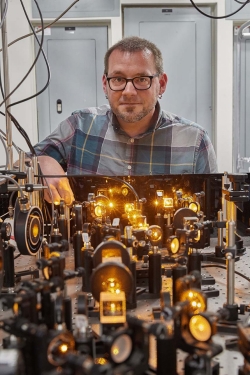NORMAN, OKLA. – University of Oklahoma professors Arne Schwettmann and Grant Biedermann recently received a research award to investigate applications of what Albert Einstein called “spooky action at a distance” from the Defense Established Program to Stimulate Competitive Research, a program within the Department of Defense. The $584,814 grant will be awarded over three years starting in the fall.
Schwettmann, a professor in the Homer L. Dodge Department of Physics and Astronomy, said their research uses nearly 20,000 atoms within a gas cooled to extremely low temperatures to study quantum entanglement and that the study has implications for quantum-enhanced sensing applications.
“In an atomic sodium gas cooled to ultracold temperatures, atoms behave like small magnets that change their orientation when they collide with each other,” Schwettmann said. “In a gas at room temperature, the collisions happen randomly and uncontrollably, but if the sodium gas cloud is cooled all the way down to about 0.00000001 degrees above absolute zero temperature, the collisions happen predictably and can be controlled via microwaves. The atomic magnets become correlated in this process. This correlation is what Einstein called ‘spooky action at a distance,’ now known as quantum entanglement.”
The collaborative research effort through OU’s Center for Quantum Research and Technology combines Schwettmann’s expertise in manipulating ultracold gases with the project’s co-principal investigator and associate professor in the Department of Physics, Biedermann. Biedermann’s expertise is in using light pulses to investigate novel schemes of atom interferometry.



